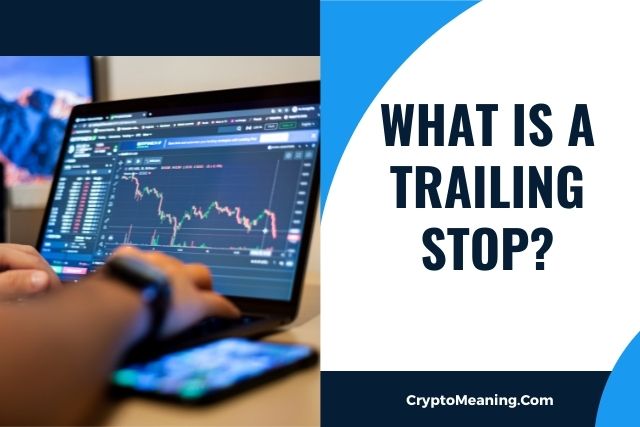Do you know what is a trailing stop? If your answer is no, then let me explain. The trailing stop is the best trading technique that allows you to set the price of the stocks or shares. If, in any case, the market price goes up or falls, then the stop price will also move with the trailing stop price.
However, this article will explain other things related to the trailing stops, like the trailing stop vs. trailing stop limit and many other things. With the help of this article, you can easily decide when you can use the trailing stop technique.
What is a Trailing Stop?
Do you know what is trailing stop and stop-loss? If no, then don’t worry; the details about stop-loss are given below. But now, if we talk about the trailing stop, then it is the particular form of the stop-loss. If the market goes up any time, then the trailing stop will impulsively keep your position and permanently save all your profit.
When the market crashes, then the trailing stop will remain in its place, and when the market goes opposite to you, it will close your position. However, the trailing stop avoids putting the stop level at the definite price point, but it definitely sets it below the exact market rate.
If you are going to open the long positions, then it will set the stop level below the price of the market, and suppose you will open the short position, then in this condition, it will set the stop level beyond the original price of the market.
Workings of a Trailing Stop
Do you know how the trailing stop works? Let me explain to you, actually, at the time of market price increases; the trailing stop will also increase along with the market price. When the market price stops growing, then the overall price of stop-loss will go to the previous price from where the trailing stop starts dragging with the market price.
In this way, the investors will automatically protect their profit by locking it when the price touches the new height. Now we will explain it with the help of an example, and this thing will offer you a better understanding. Suppose the stock is present with the given below data:
$10 is the purchase price
The $10.5 is the final price when the trailing stop is in place
The trailing amount is 20 cents
$9.85 is the value of stop-loss
Now, if the value of the market goes up to $10.97, then in this situation, the value of the trailing stop will also increase up to $10.77. Once it again goes down to $10.90. At that time, the value of the trailing stop will not go down because it remains the same $10.77.
When you submit your order, it will be submitted according to the final price, like $10.76. Suppose that the $10.75 was the bid price at that time, and the position was closed at that price, then it means you will get the $0.75 profit per share.
What is Stop-loss Order?
When the asset price goes to its special price any time, then the stop-loss order is used to sell the asset. The main reason to use the stop-loss order is to restrict the profit and loss you get in trading. You have the unlimited opportunity to use the stop-loss order concept for long-term trading and short-term trading.
The other name of stop-loss order is stop-market order, and it is also called stop-order. The stop-loss order is an automatic order that the investor places. If an investor places a stop-loss order, then it means the investor ordered the agent that sells the security when it comes to the decided price range.
If we explain it in detail, then in the stop-loss order concept, the broker or the agent helps the investor with the help of trading discipline. Basically, with this, the broker helps the investor cut their losses when selling the stocks. We want to explain it with an example; you will quickly understand the whole concept.
If an investor places a bid at a specific price for any company shares, then in this situation, the investor will order the agent to set the cost upon purchasing the stock. And when the price of the stock goes up, then the order will automatically be performed. Other than this, it might be possible that you contain the share of any company.
If you want to sell the shares, then the best option for you is to ask your agent to sell all the shares when the prices go to their specific height, or it falls. However, the order will automatically work when the prices reach their pre-sets. As we already mentioned, the stop-loss order is for both long and short-term trading.
And usually, this concept is used when an investor doesn’t want to take the stress of observing the security daily. However, the stop-loss order concept is the best for small investors and a beneficial technique.
Trailing Stop vs. Stop Loss Order

If we talk about the stop-loss order, then the main work of this technique is that the broker sells your position when the prices fall to a pre-set price. Suppose if you are an investor and have some shares of any company, you are trading $80 per share.
But if the price falls to $78, you have to sell all your shares, and in this way, you entered into the stop-loss order concept. It might be possible that the price will touch the $78 or goes down, then your broker will enter into the market order. Remember one thing that there is no guarantee the price will be $78.
If you want to enter into a stop-limit order, you can do this. In the stop-limit order, you can quickly identify the price to activate the order, and you can also restrict the price to determine the minimum price you can easily accept.
Using the Trailing Stop/Stop-Loss Combo on Active Trades
On the active trades, it is challenging to apply the trailing stop. This is because the price fluctuates too much. And also, in the first hour, there are too many ups and downs in stocks.
However, the thing that attracts the traders too much is the fast-moving speed of the stocks. These fleet stocks can generate more money shortly. Let’s understand this with the help of the below given example.
The purchasing price is $80.13
There are a total of 500 shares
$79.70 is stop-loss
The amount of trailing stop is $0.49
The amount of other trailing stop is $0.40
The next trailing stop price is $0.25
Suppose we have stock A, and the price of stock A is $80.13, along with the amount of $79.70 stop-loss value. If we talk about the cost of the first trailing stop, then it is $0.49. But if the final price goes to $80.20, then in this situation, the trailing stop starts their work, and the stop-loss will end.
And when the final price goes to $80.54, then the trailing stop will screw up to $0.41. When the price goes to $82, then it is time to make a stop. If the final price decreased to $81.97, then the cost of the trailing stop will be $0.25 instead of $0.41. After this, if the price dropped to $81.48 on the low profit and the entire shares for $81.70 were sold.
However, after the commissions, the profit you will get is 1.74%, or $842. If you want this plan to go to the active trades, then for this first, you should set the value of the trailing stop. This thing will adjust the fluctuations of the regular price, especially for the specific stock. You can quickly achieve this technique, but you should study the stock before the trading day.
Trader Risk
The traders who always use the stop-loss technique then they face different types of risks. If you are a beginner, the market maker already knows very well of every stop loss you put with your agent’s help. They decrease the price to hit you out from the competition, and after this, they will quickly increase the price again.
Frequently Asked Questions (FAQs)
How does a trailing stop order work?
The main work of the trailing stop technique is to set the stop price, and it will be below the market price. When the market price goes up, then the trailing stop price will also go up in this situation. But if the stop price of the market will decrease, then the trailing stop’s price will remain the same.
What is a trailing stop order example?
Suppose the price is 10 cents that go up; in this condition, the trailing stop price will also go up to 10 cents. If the price goes up to 20 cents, then the trailing stop price will also increase to 20 cents. But when the price falls, then the price of trailing will remain the same.
What is a good trailing stop percentage?
It is a fact that the trailing stop is better as compared to the traditional stop loss. If we talk about the best percentage of trailing stops, it is 15% to 20%.
What is the difference between stop loss and trailing stop?
When the position price increases, the latter goes up in the trailing stop and is the primary difference between the trailing stop and the stop loss.
Conclusion
Well! That’s all about what is a trailing stop so far. I hope with the help of the information given above, you know very well about trailing stop and everything about trailing stop trading. You can easily use the trailing stop technique to get more profit in the trading world.





